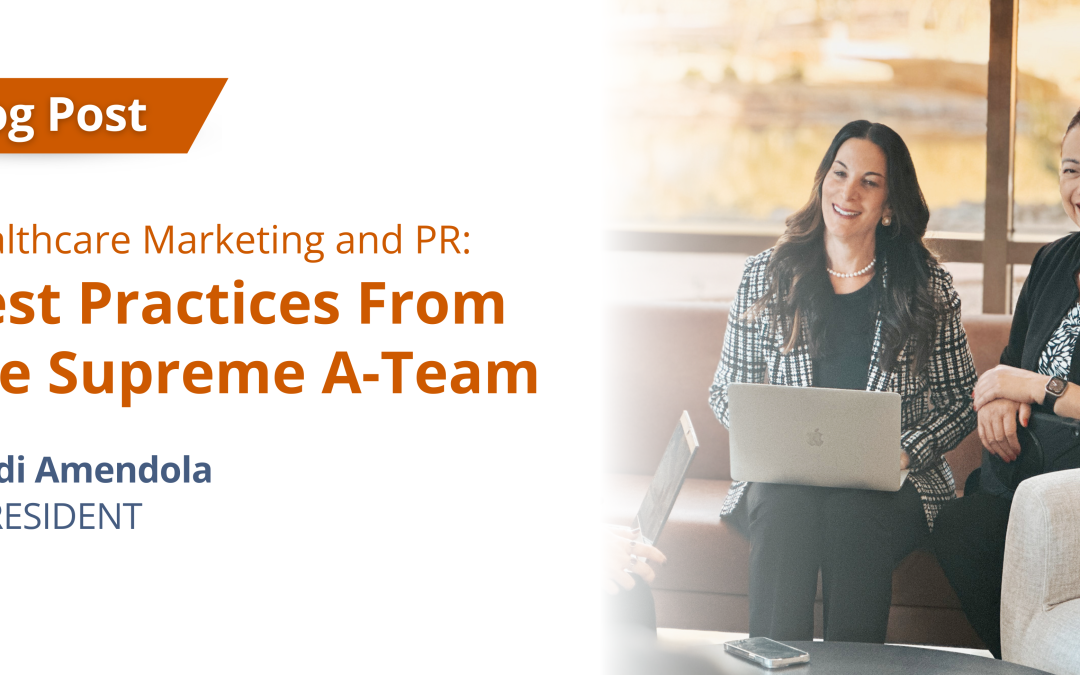
by Chris Nerney | May 28, 2025 | Blog
Some health technology entrepreneurs are absolutely convinced their company has a unique, revolutionary solution that will transform healthcare. And they will not hesitate to tell you!
Most, however, are more grounded. They only have to look around to see that the problems their solution is designed to solve – whether it’s clinical data quality, patient identity, billing accuracy, etc. – have attracted the interest of other clever and well-intentioned people. They have competition! Worse, some of these sector rivals are well-funded.
Which doesn’t mean your solution is any less genuinely transformative to healthcare consumers, providers, payers, or researchers. What it does mean is you likely face a formidable challenge in rising above the noise in your sector to attract and capture the attention of potential customers and investors. After all, there are a lot of stories being told out there.
So how can healthcare PR and marketing pros make their company’s story compelling enough to break through and stand out in a crowded market? For starters, health tech companies can gain a market advantage by clearly articulating (and repeating) across multiple channels what problems their solutions solve and how these solutions benefit patients. Why should customers choose your solution and not a competitor’s? You need a great answer to that question.
Hone your marketing language to highlight your company’s competitive differentiators. Once you’ve locked in on a framework for your messaging, you can deploy several specific techniques to help your health tech company rise above the clamoring masses. These include:
Practice precision marketing
The marketing messages that resonate with potential customers such as provider organizations or payers may not resonate with investors. While a hospital or health plan will want to know what your technology costs and how it would help them improve care quality or operational efficiency, they’re not interested in a graphic showing the projected growth of your startup’s market sector. Investors, on the other hand, care deeply about a sector’s growth potential as well as a prospective portfolio company’s strengths and weaknesses (particularly its technology and leadership team) relative to the competition.
It is essential that you learn the needs and pain points of each target audience and then tailor a message that specifically addresses them. Try to get feedback from members of your target audience (or people who understand their concerns and priorities) and then modify as necessary.
Go multimedia
We may be in the technology business, but humanity sells. The human connection is a powerful thing; people like to hear and see other people talk. That’s one of the reasons why podcasts have become so popular. If there is someone in your company who could shine on a podcast, do not hesitate to get that person some training and some bookings.
No matter how nervous your subject matter expert may be, once they see the positive response internally and externally, they’ll be pestering you for more podcast opportunities. Then they’ll ask for help getting an agent.
You also can use multimedia in social media and in press releases. Spice up your messaging with pictures, graphics, and even short videos. You won’t need to hire a crew for a three-camera shoot, either; videos can easily be recorded on a smartphone.
Get customers to tell their story
I know, it’s one of the hardest things in marketing. A health tech company’s customers – whether they’re a hospital, health system, payer, or academic center – may not want to get involved in your marketing efforts because 1) they’re pretty busy doing their own jobs, and 2) they worry about being perceived as shills for a vendor. From their perspective, those aren’t unreasonable concerns.
But you won’t know what your customers say until you ask. Suggest doing a white paper on their experiences with your solution or ask for one of their spokespeople to join you on stage at an industry conference or for a podcast. People like to talk about their successes and impart advice to colleagues. It’s all upside to them.
One great selling point for healthcare marketing and PR pros who are trying to get a customer to share their experiences is to emphasize that the customer’s story (and yours) centers around how they were able to better serve patients using your technology, not the merits of the technology itself (which should be apparent in the telling of the story). Again, it’s an opportunity for the customer to talk about what they’re doing to help patients, research, or efforts to control healthcare costs.
Conclusion
To succeed in highly competitive markets, health tech vendors need a coherent message centered around how their solution benefits both patients and potential customers. By tailoring these messages to targeted audiences, leveraging the power of multimedia to build human connections, and working with customers to communicate powerful success stories, health tech vendors truly can stand out in a crowded market.

by Morgan Lewis | Mar 5, 2025 | Blog
Now that we’re well into 2025, I thought it would be interesting to look back at the most-read blog posts of 2024. My theory about these popular posts is that they reflect the concerns, curiosities and goals of the larger population of that time … or it could just be our team’s savvy SEO strategies and engaging writing skills that kept readers reading.
Regardless, last year’s most-read posts indicate that visitors were looking for levity, given the many popular articles’ lighthearted nature. This is also understandable, considering that many of us were looking for some relief in 2024 from the nonstop barrage of news about the U.S. Presidential campaign.
Another theme that emerged is that several of you – despite the growth of ChatGPT and other generative AI writing tools – seemed to be looking for writing tips and commentary to improve your content. Hooray for real-life human writers!
Without further ado, the following are the top 5 most-read Amendola blog posts from 2024 (in chronological order).
Top 5 Most-Read Blogs of 2024
- “The Taco Bell Times And The Depends Undergarments Press: Is This The Future Of Local News?” by Brandon Glenn.
This amusing post kicked off the year by first discussing an unfunny trend: the widespread closures of daily newspapers and layoffs of journalists. This topic is close to our hearts at Amendola, given that many of us came from consumer and business journalism before jumping to PR. The post, however, does steer toward levity as Brandon explores what could happen if mega-corporations step in to “save” local newspapers by purchasing naming rights or other such business ventures (which occurred at his hometown’s newspaper). What could go wrong?
- “The Best Rule in AP Style is About Animals with Names” by Brandon Glenn.
Brandon returns to the most-read blogs list with his hilarious take on an obscure Associated Press-style rule about pronouns for animals with and without given names. As a follower of AP style (the most common writing manual in consumer and business journalism) for over 25 years, I cannot remember ever looking up if I should refer to a dog named Rex as “who” or “that” in a sentence. Thankfully, the style guide editors resolved this dilemma, which Brandon whimsically explains. So, which is it? You’ll have to read the post to find out.
- “Reflecting Back, Looking Forward: Amendola Marks 20th Anniversary,” by Jodi Amendola.
Our founder and CEO, Jodi Amendola, has seen it all in health tech: digital transformation, the rise of virtual care, COVID-19, and now, generative AI. Jodi’s vast experience and success are likely why so many blog visitors read her post on the 20th anniversary of the agency she launched out of her parents’ condo in Scottsdale, Arizona. Her secret? Jodi humbly admits that she doesn’t have a crystal ball to foretell the industry’s tumultuous changes. Instead, preparing for the unexpected, staying nimble and building the right team have made all the difference over the last two decades.
- “When Slow is the Way To Go in PR and Marketing,” by Chris Nerney.
Post-author and Senior Content Director Chris has decades of experience in journalism, PR, and marketing content, as well as five years as a standup comic in Boston. His wit shows through in this post about the occasions where speed is more of a risk than a benefit. Although filled with valuable and actionable information, Chris injects plenty of humor in describing situations professionals in our industry will recognize. For example: “…you may be writing about concepts that may be ever-so-slightly outside your wheelhouse. That’s OK – you probably didn’t go to medical school, and your yearslong devotion to Grey’s Anatomy will only get you so far.”
- “The ABCs and the 3 Ps of Media Interviews,” by Grace Vinton.
Our media relations dynamo and health-tech celebrity, Grace Vinton, offers advice on a perennial challenge facing health-tech PR and marketing professionals: media interviews. Grace, who has a hugely popular podcast of her own, presents helpful mnemonic devices in the post for health tech executives to prepare for interviews and tips for crafting memorable and easy-to-understand messages. Her guidance is also relevant for any chat with a potential customer, investor or partner where you may not have the time for a detailed discussion about your company and solutions.
New Year, Fresh Insight
Whether it’s writing tips, messaging advice, or insight into the health tech PR and marketing strategies, you can continue to rely on this blog in 2025 to supply you with relevant guidance. I can’t promise that all the posts will be humorous, but they will surely be engaging and informative. Thanks for reading!

by Administrator | Jan 28, 2025 | News
SCOTTSDALE, Ariz., Jan. 28, 2025 – Amendola Communications (Amendola), part of Supreme Group, announced today that it has been selected by Life365 Health, a leading developer of virtual care technology solutions that enable healthcare delivery at home, to implement a national PR/marketing program.
“Life365 Health chose Amendola to help drive awareness and interest in our AI-driven platform, because of its deep understanding of healthcare, strong media relationships, senior level team and expert writers,” said Kent Dicks, CEO and founder. “Our technology goes beyond remote patient monitoring (RPM) to help healthcare organizations manage large patient populations in a proactive, pre-emptive, prioritized, and personalized manner. We look forward to collaborating with Amendola to more broadly share the story of how we help healthcare organizations monitor populations, improve patient engagement, and control costs.”
Amendola is implementing a comprehensive program of messaging, marketing, public relations, and social media to demonstrate Life365 Health’s industry-leading technology and services, accomplishments, customer wins, and industry partnerships, including those with Veterans Affairs and Microsoft.
Life365 Health has continually set the standard for innovation in RPM and virtual care solutions. The company’s mission is to enable new models of care where technologies, like AI and machine learning, play a crucial role in connecting with a large population of patients to receive insights from home to prioritize those who may be headed to more costly locations.
“Far too often, the RPM process engages with patients far too late, after patients have been discharged from the hospital in a reactive and expensive manner,” said Jodi Amendola, agency CEO. “Life365 is changing this outdated and ineffective model by advancing healthcare delivery with leading-edge technology that enhances patient engagement, personalized care, and facilitates proactive interventions to improve outcomes. We are delighted to help this leader in at-home virtual care expand its customer base and market presence.”
About Life365
Life365 Health is a leading developer of virtual care technology solutions that enable healthcare delivery at home. The Life365 platform addresses key care delivery challenges by providing scalable solution integration and logistics to enterprise healthcare organizations, to enable patient connectivity, engagement, and improved outcomes for their patient populations at home. The platform provides a single integration point that enables providers, payers, and others to utilize a proactive, virtual first care approach to remotely engage and monitor patients with a variety of conditions and needs. These include chronic disease management, post-discharge care, and population health management.
Life365 is led by an experienced, industry recognized team and is a major patent holder of wearables, sensors and patches driven by machine learning / AI, to drive the next generation of remote patient monitoring to scale. Life365 is a strategic partner of Microsoft Cloud for Healthcare and the Veterans Association, serving the largest population of Veterans in the world.
For more information regarding Life365, please visit www.life365.health.
About Amendola
Amendola, part of Supreme Group, is an award-winning, insights-driven public relations and marketing firm that integrates media relations, social media, content, and lead gen programs to move healthcare, life sciences/pharma and healthcare IT decision-makers to action. The agency represents some of the industry’s best-known brands as well as groundbreaking startups disrupting the status quo. Nearly 90% of its client base represents multi-year clients and/or repeat client executives. Amendola’s seasoned team of PR and marketing pros understand the ongoing complexities of the healthcare ecosystem and provide strategic guidance and creative direction to drive positive ROI, boost reputation and increase market share. Making an impact since 2003, Amendola combines traditional and digital media to fuel meaningful and measurable growth. For more information about the industry’s “A-Team,” visit our website and follow us on LinkedIn.
Media Contact
Philip Anast
Amendola for Life365 Health
panast@acmarketingpr.com

by Jodi Amendola | Jan 22, 2025 | Blog
One of the great pleasures of my job is watching members of the Amendola team – the A-Team – demonstrate their knowledge and expertise about public relations and marketing. I see this during staff meetings, on calls with clients and prospective clients, and in the work the A-Team produces for the many companies we represent. I go to sleep every night knowing I hired a team of senior level experts that truly shine.
Over the past year, A-Team members have offered their collective marketing and public relations wisdom through the Amendola blog. As I look back on 2024, I wanted to share with readers some of the blog posts that resonated most with me. Honestly, I could have made this list three times as long! I urge you to click on the links and check out some of the other Amendola posts. They are filled with actionable advice for healthcare technology companies seeking a competitive edge.
Spotting PR opportunities hiding in plain sight
Healthcare technology clients hire Amendola to help them raise their profiles in an exceedingly competitive business environment. And while many clients envision lavish write-ups in the Wall Street Journal or prominent healthcare media – something we’re all for, by the way! – coverage by smaller news outlets can be useful in building brand awareness among potential customers and investors.
“Though often overlooked, local news outlets can be valuable resources for public relations professionals and their clients,” our Senior Content Director Brandon Glenn notes in this blog post from January. “Whether they are general interest dailies, weeklies, or business publications, these media outlets are often interested in milestone topics that don’t necessarily appeal to trade or national media, such as hiring plans, headquarters’ expansions, acquisitions, and other factors that may affect the local economy.” See the opportunity, seize the opportunity.
Take the trade show by storm
Trade shows can cost healthcare technology companies a lot of money, especially if they have a booth on the show floor. It’s important, then, to get the most out of a trade show – otherwise you’re wasting time and funds that could be used elsewhere.
In addition to providing a forum for education and professional networking, trade shows can enable healthcare technology companies to build relationships with the media. In a February blog post, Account Director Kim Mohr offers some best practices for executives seeking to establish relationships with journalists from a variety of publications and mediums. These include preparing for scheduled interviews, being prompt (the journalist’s schedule will be crammed) and having a clear message (more on that later).
Fortune favors the bold – and creative
Amendola clients want to be noticed by investors and prospective customers. Yet they don’t want to stand out for the wrong things. As a result, many of them fear that expressing a strong opinion or point of view will distract from their message and cost them business.
But as Account Director and Media Specialist Grace Vinton warns in this May blog post, “Healthcare technology companies that hide in the herd and play it safe get ignored.” A far more effective strategy, Grace writes, is to “inject your marketing and PR initiatives with a strong storyline framework that employs passion, humanity, humor, and a distinctive voice.” This can be done through social media, bylines, podcasts, and (as discussed above) speaking at conferences. Humanity sells because we’re all human.
Simple sentences, clear messaging
To build brand awareness and grow revenue, healthcare technology companies need clear, concise messaging. That can be difficult when you’re in the business of applying advanced technologies to complex healthcare challenges.
Still, language that is “direct, straightforward and, above all, clear and free of unnecessary jargon” will pay off in the long run. In an August blog post, Amendola Senior Account and Content Director Jim Sweeney explains, “Keeping it simple means your message will be better understood and your busy readers will be grateful for not having to decipher your writing.” Couldn’t have said it better (or simpler) myself.
Compelling lead magnets
Strong customer leads are the refined fuel of the sales pipeline. Healthcare technology companies can use lead magnets to capture and nurture promising leads by offering value in exchange for their contact details.
The best lead magnets are tailored to your target audience’s needs, deliver the value promised, are easy to consume, and can be readily shared, according to Senior Account Director Janet Mordecai. But that’s just a partial list; read about more characteristics of winning lead magnets in Janet’s October blog post.
Conclusion
2024 was an amazing year. In fact, we are bigger and better now as we are part of the Supreme Group. My crystal ball tells me that 2025 will be even better. The A-Team and I can’t wait to continue working with clients whose technologies will help transform healthcare to save and improve lives. We’re in this together.

by Chris Nerney | Jan 8, 2025 | Blog
The start of any year is an ideal time for healthcare companies to review and, if necessary, revise their brand messaging. The industry moves fast, and the message that resonated in January may be gathering mold a few quarters later. Or a healthcare company may want to reach a new target audience as its product evolves and market dynamics change.
Here are three possible marketing and public relations resolutions for 2025 that, if embraced, will help healthcare companies raise their profiles and distinguish themselves from the growing crowd.
Lose the meaningless jargon
Stop telling people your company is “transforming healthcare.” It’s a meaningless phrase used by virtually every healthcare startup. I know because I’ve typed variations of the word “transformational” at the behest of countless clients. I haven’t crunched the numbers, but I’d say there are almost as many companies claiming they’re transforming healthcare as there are “visionaries,” “innovators,” and “trailblazers” on LinkedIn.
Likewise, try to eliminate words and phrases such as “value proposition” and “leveraging,” which are best left for business-school debates. As Amendola founder Jodi Amendola wrote in Forbes last summer, such words “are so tired that they have come to mean virtually anything to anyone, and in turn, they have lost all effectiveness in conveying a unique, memorable marketing and communications message.”
If you’re not unique, you don’t stand out. And if you don’t stand out, you’re essentially invisible. Not exactly the “value proposition” you want from your marketing and PR initiatives, is it? Don’t give potential customers a reason to tune you out.
I also think we’re at the point where healthcare companies need to evolve their messaging beyond terms such as “patient journey” and “social determinants of health,” both of which feel dry and disconnected from real people. Unfortunately, I have no better suggestions. Perhaps an innovative, trailblazing visionary can step forward.
Establish a multimedia presence
When social media took off, some healthcare companies became aggressive early adopters while others held back, not sure whether LinkedIn, Twitter, Instagram, and other social platforms were worth their time. If they had to do it all over again, I suspect the laggards would have moved faster to expand their messaging through these channels.
Don’t make the same mistake with multimedia. Audio and video are powerful mediums not only for communicating information, but for connecting with people. For as powerful as the printed word can be, nothing compares to listening to a person talking or watching them speak.
Printed words can’t communicate vocal inflections, eye contact, or a sincere smile the way multimedia can. While these things may not have anything to do with your product’s capabilities or a customer’s specific problems, they can convey a level of trustworthiness and credibility that the printed word can’t match.
A lot of healthcare companies are taking advantage of audio and video podcasts to deliver their message. It would be smart to use those acquired skills to produce short videos for LinkedIn and other social media platforms that make sense for your company. Including videos in press releases is another way to attract media coverage. None of this requires the construction of a video studio; a smartphone and uncluttered background is enough.
Get customers to tell your story
One of the most common challenges facing healthcare companies is persuading customers to help spread the word about their products and services.
Easier said than done, I know. There often are valid reasons why a customer doesn’t want to be co-opted into your PR strategy: They’re busy, they don’t want to be perceived as endorsing a product, and besides, it’s not their job to promote your “transformational” solution.
Nobody, however, is going to tell your story as effectively as a satisfied, real-world customer whose problems you helped to solve. This type of testimonial will resonate with a prospective customer far more deeply than your company pitch deck. Further, having a customer willing to speak publicly will exponentially increase your company’s chances of getting onto conference stages (and thus in front of your target audience). That alone will separate your company from the pack.
Your best chance of getting a customer to talk about your product is to emphasize the genuine benefits to them and remove obstacles (such as investments of time) that are disincentives to participation. If they are truly impressed with your product and you make the process easy for them, customers will be far more likely to talk about how your company’s product helped them. If companies with similar challenges are listening, this messaging will catch their attention.
Page 1 of 712345...»Last »





